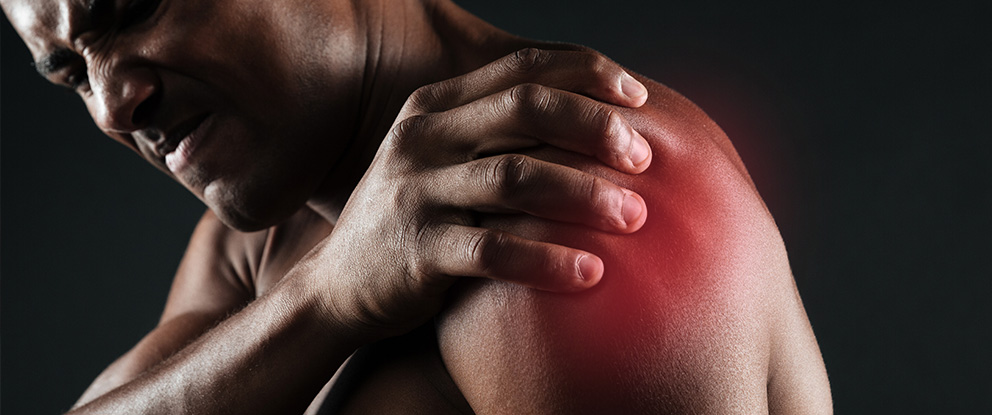Rotator Cuff Tendinitis, a.k.a. Impingement Syndrome
Your rotator cuff is a group of 4 muscles that move the shoulder joint. It is also responsible for shoulder stability. The rotator cuff tendons pass through the subacromial space, which is a narrow tunnel between the bony projection (acromion) on top of your shoulder and the head of your upper arm bone, or the humerus. Tendonitis or tendinitis happens when one of these tendons gets caught, pinched or compressed against the bone during arm movements. Of the four cuff muscles, the supraspinatus tendon is most commonly affected. The tendon gets irritated and eventually becomes inflamed and painful with overhead movements.
- Tendinitis: acute inflammation due to trauma to a tendon
- Tendinosis: a chronic condition from repetitive trauma to a tendon
Rotator cuff tendinitis responds well to physical therapy and people regain full shoulder function.

Rotator Cuff Tears
Rotator cuff tendonitis can lead to rotator cuff tears if left untreated. Prolonged and continuous inflammation of these tendons can result in deterioration, which may weaken and eventually tear the tendon. When it happens, people have pain and difficulty with elevating their arms and performing overhead activities. They often have pain at rest and are unable to sleep on the affected side. Treatments depend on whether you sustained a partial or full-thickness tear, although most of the cases respond very well to Shoulder Physical Therapy. The sooner you start the treatment, the better outcome you will achieve. If left untreated, rotator cuff tear may progress to the point where surgery is needed.
Bicipital Tendonitis
The long tendon of your biceps passes through a tunnel (bicipital groove) in front of your shoulder, where it slides up and down during arm movements. When this tendon gets irritated and inflamed as it glides within the enclosure during repetitive overhead shoulder motions, it can be excruciating and limit shoulder movements.
Bicipital tendinitis responds well to physical therapy treatments.
Subacromial Bursitis
Bursa is a fluid-filled sac located in between your acromion and rotator cuff tendons. Bursa serves as a cushion between the bony prominences and underlying soft tissue structures, providing a smooth surface for the tendons to glide over with shoulder movements. Overuse of the shoulder with overhead activities may irritate the bursa, resulting in a painful condition called bursitis. Symptoms of bursitis include pain with arm elevation, especially to the side. The pain increases as you lift the arm closer to the level of the shoulder.
Bursitis is treated with physical therapy, and the prognosis is good.
Arthritis
The most common type of arthritis involving the shoulder is osteoarthritis or the “wear and tear.” Often present in older people, osteoarthritis progresses over time until symptoms of swelling, pain, and stiffness begin to affect daily activities. The condition is often debilitating with painful restrictions of shoulder motions. Other forms of arthritis that may inflict shoulder pain are rheumatoid arthritis and post-traumatic arthritis.
Physical therapy helps people with arthritis regain shoulder motion and restore strength and function.
Adhesive Capsulitis, a.k.a Frozen Shoulder
The shoulder joint is enclosed in a protective capsule. Inside the capsule, there is synovial fluid that lubricates the joint for a smooth glide during movement. The synovial membrane, which is a lining of the capsule, may become inflamed and over time may thicken, resulting in severe tightness and restricted range of motion. People who have frozen shoulders have severe difficulty with simple things like brushing their hair, reaching up, reaching behind the back, or sleeping on the affected side. Adhesive capsulitis has no known cause and initially presents with progressive pain and worsening limitations in motions; however, it responds well to physical therapy, and people regain full arm function.
Calcific Tendonitis
Calcium deposits may build up in the tendons, which frequently occurs at the shoulder in the rotator cuff tendons. There is no identifiable cause for this condition, but studies found an association with excessive use of the arm in overhead motions. Physical therapy helps someone with calcific tendinitis to regain motion and strength and to decrease pain.
Beware of Other Causes of Shoulder Pain
There are many causes of shoulder pain; however, the problem may be elsewhere. Therefore it is important to seek consultation with a physical therapist who can help to pinpoint the exact cause of your shoulder pain to address it with appropriate treatment.
Often, the “shoulder pain” can be a neck problem even though the pain is present in the shoulder. You may occasionally feel tingling, numbness, and weakness in your arm and hand, suggesting spinal nerve involvement.
Pain in the shoulder area could also result from abnormal or dysfunctional movement due to the weakness of the shoulder blade muscles. A physical therapist will assess the muscle strength and the movement patterns. You will be prescribed particular exercises that will result in regaining full function without pain.
Managing your shoulder pain with home remedies may only be making the matter worse. If action is not taken timely, it may result in considerable loss of strength and function.
The sooner you address the problem, the easier it will be to get you back to normal.
If your shoulder pain gets to the point where it starts to affect your quality of life, it’s good to have it checked out, and Shoulder Physical Therapy is a great option for that! Here at Action Physical Therapy, we will be happy to help you determine the cause of your pain and get you back to doing things you love!

